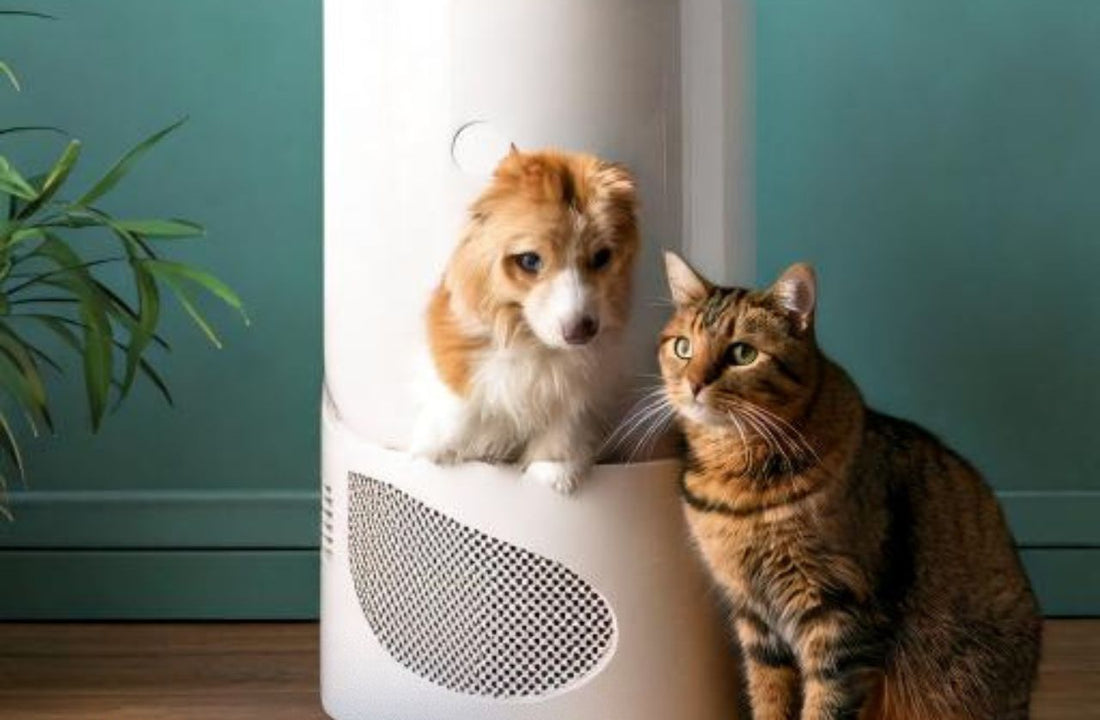Indoor air quality plays a significant role in both human and pet health. For households with pets, air purifiers offer numerous benefits, including reducing allergens, odors, and airborne irritants. However, certain air purifier technologies may carry potential risks for pets, especially those that emit ozone or use ionizing mechanisms.
In this article, we’ll explore the advantages and considerations when using air purifiers around pets, including how Hari Hats brings a portable, pet-friendly solution that effectively manages air quality without harmful emissions.
Benefits of Air Purifiers for Pets
- Reducing Pet Dander and Allergens: Pets produce dander, a common allergen, along with dust and airborne hair. HEPA filters in air purifiers are particularly effective for capturing pet dander and other allergens. Reducing airborne allergens helps pets with sensitive respiratory systems and can relieve symptoms in pets with environmental allergies. Hari Hats uses HEPA filtration in its wearable devices, which can be especially helpful in environments where pets may encounter allergens.
- Controlling Pet Odors: Pet odors, from litter boxes to natural animal scents, can be neutralized by air purifiers with activated carbon filters. Activated carbon captures volatile organic compounds (VOCs) that contribute to these odors, creating a fresher indoor environment for both pets and owners. Hari Hats incorporates activated carbon filters, making it a practical option for odor control on the go.
- Minimizing Dust and Hair: Although air purifiers cannot capture all pet hair, they help manage airborne dust and hair particles, reducing buildup on surfaces and improving overall air cleanliness. The pre-filter in Hari Hats traps larger particles like hair and dust, making it a versatile option for portable air purification.
- Improving Overall Air Quality for Pets: Clean air is essential for pets, especially those prone to respiratory issues. By capturing allergens, odors, and dust, air purifiers help create a healthier environment, supporting long-term respiratory health in pets.
Potential Risks of Air Purifiers for Pets
- Ionizers and Ozone Production: Are They Harmful?: Some air purifiers use ionization or produce ozone as a byproduct, which can be harmful to pets’ respiratory systems. Ozone exposure may worsen symptoms in pets with asthma or other respiratory conditions and can irritate their airways. Hari Hats avoids ozone-producing technologies, making it safe for pets and humans alike.
- Sensitivity to UV Light and Its Effects on Pets: UV light purifiers are effective for bacterial removal but can be problematic for pets if not shielded properly. Pets with sensitive eyes and skin may be at risk if directly exposed to UV rays.
- Noise and Stress: How Air Purifiers Affect Pet Behavior: Noise from air purifiers can be stressful for some pets, particularly those sensitive to loud sounds. Models with low decibel ratings (below 40 dB) are typically quieter and more pet-friendly. Hari Hats offers a low-noise solution, ideal for use around sound-sensitive pets like cats and small dogs.
- Overuse and Its Impact on Pets Respiratory Systems: Excessive use of air purifiers may alter indoor humidity, which can affect pets’ respiratory comfort. Monitoring purifier use and maintaining proper ventilation are recommended to prevent dryness.
Types of Air Purifiers Safe for Pets
- HEPA Filters and Their Pet-Friendly Benefits: HEPA filters capture particles as small as 0.3 microns, making them effective for dander, dust, and small allergens. They do not emit harmful byproducts, making them a safe choice for pets. Hari Hats integrates HEPA filtration, providing portable, pet-safe air purification.
- Activated Carbon Filters for Odor Control: Activated carbon filters absorb VOCs and neutralize pet odors. Combining HEPA and activated carbon filters, as Hari Hats does, is ideal for households with pets that produce strong odors.
- Pet-Specific Air Purifiers: What to Look For: Air purifiers designed for pet households often feature dual filtration systems for dander and odor control. Hari Hats offers similar benefits in a wearable format, providing a versatile, portable solution.
- Avoiding Air Purifiers That Emit Ozone: It’s crucial to avoid purifiers that produce ozone or use ionization. Ozone can be harmful to pets’ respiratory health.
Placement and Usage of Air Purifiers in Homes with Pets
- Best Locations to Place Air Purifiers for Maximum Effect: Position air purifiers in areas where pets spend most of their time, such as near their bedding or litter box. This ensures effective dander and odor removal. Hari Hats offers flexibility by allowing for personal air purification in various locations.
- Avoiding Areas Where Pets Spend Most of Their Time: Avoid placing loud air purifiers directly in resting areas to prevent stress. Hari Hats is designed to operate quietly, making it suitable for use in pet-friendly spaces without causing disturbance.
- Frequency of Use and Filter Replacement in Pet Homes: Frequent use and timely filter replacement are essential in pet households to maintain air quality. Hari Hats is engineered with replaceable filters, ensuring long-term use while capturing pet-related contaminants.
Conclusion
Air purifiers can enhance indoor air quality, benefiting both pets and their owners by reducing allergens, odors, and airborne particles. For pet owners, choosing models without ozone emissions, such as Hari Hats, is essential for safety. Offering HEPA and activated carbon filtration, Hari Hats provides pet-friendly air purification for both indoor and outdoor environments. For more information, visit harihats.com.
Also Read
